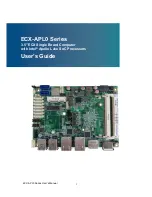
enCoRe™ V CY7C643xx, enCoRe™ V LV CY7C604xx TRM, Document No. 001-32519 Rev *H
239
Section E:
Glossary
The Glossary section explains the terminology used in this technical reference manual. Glossary terms are characterized in
bold, italic font
throughout the text of this manual.
A
accumulator
In a CPU, a register in which intermediate results are stored. Without an accumulator, it is neces-
sary to write the result of each calculation (addition, subtraction, shift, and so on) to main mem-
ory and read them back. Access to main memory is slower than access to the accumulator,
which usually has direct paths to and from the arithmetic and logic unit (ALU).
active high
1. A logic signal having its asserted state as the logic 1 state.
2. A logic signal having the logic 1 state as the higher voltage of the two states.
active low
1. A logic signal having its asserted state as the logic 0 state.
2. A logic signal having its logic 1 state as the lower voltage of the two states: inverted logic.
address
The label or number identifying the memory location (RAM, ROM, or register) where a unit of
information is stored.
algorithm
A procedure for solving a mathematical problem in a finite number of steps that frequently
involve repetition of an operation.
ambient temperature
The temperature of the air in a designated area, particularly the area surrounding the enCoRe
Vdevice.
analog
As opposed to digital, signals that are on or off or ‘1’ or ‘0’. Analog signals vary in a continuous
manner. See also
analog signals
.
analog output
An output that is capable of driving any voltage between the supply rails, instead of just a logic 1
or logic 0.
analog signals
A signal represented in a continuous form with respect to continuous times, as contrasted with a
digital signal represented in a discrete (discontinuous) form in a sequence of time.
analog-to-digital (ADC)
A device that changes an analog signal to a digital signal of corresponding magnitude. Typically,
an ADC converts a voltage to a digital number. The
the reverse operation.
AND
See
API (Application Pro-
gramming Interface)
A series of software routines that comprise an interface between a computer application and
lower-level services and functions (for example, user modules and libraries). APIs serve as
building blocks for programmers that create software applications.


































